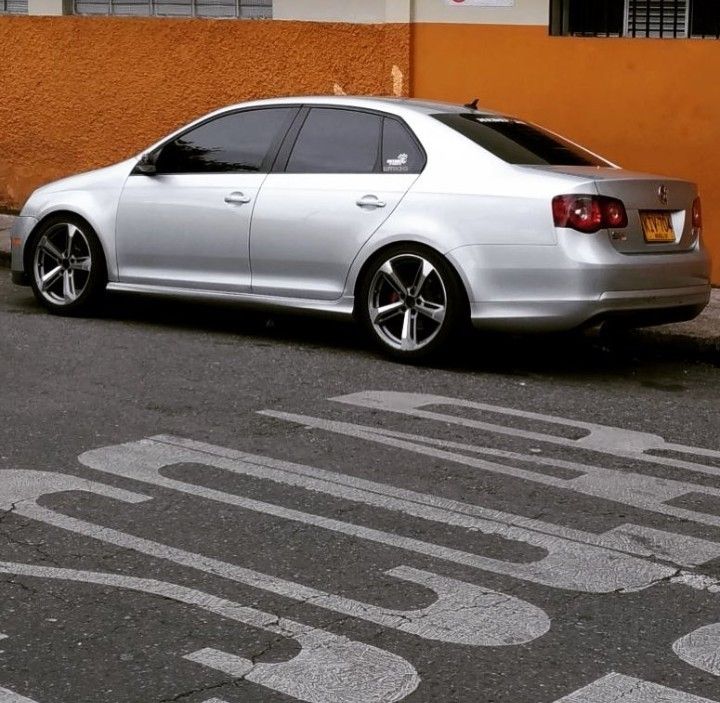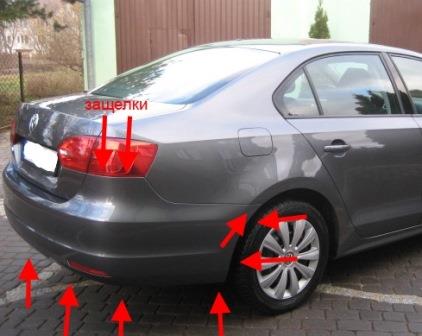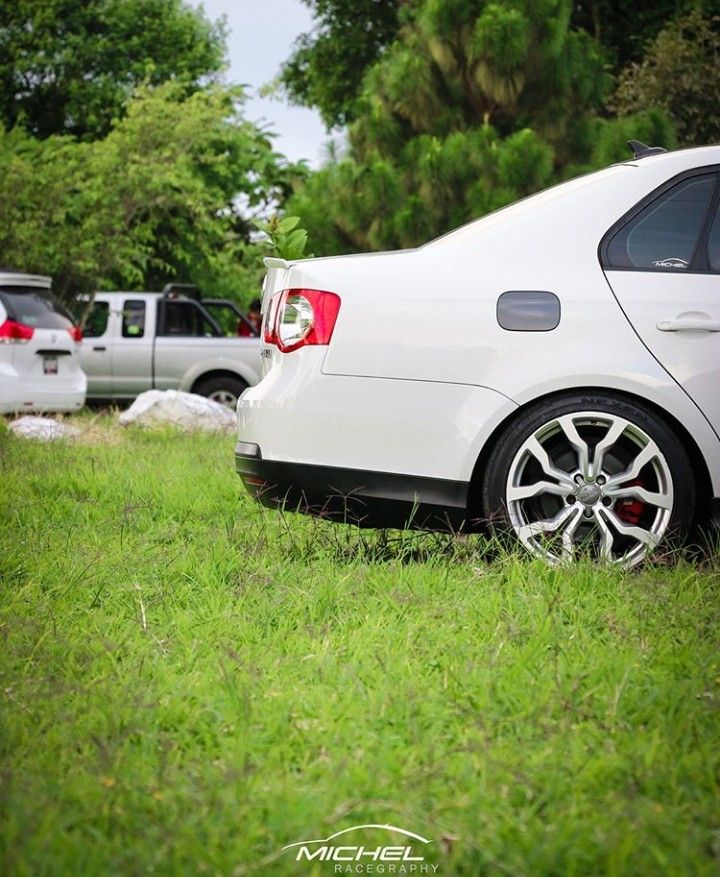4710 NW 39th St.
Directions Oklahoma City, OK 73122
Hide Show
Click Here For Coming Soon Inventory!
Are you a driver in the Oklahoma City, Edmond, and Norman, OK, areas, trying to find out how to change a tire on your Volkswagen Jetta? Our team of experts at Oklahoma City VW is ready to offer their assistance.
Below, we've compiled the following information on how to change a tire, how long tires last, and what warning signs to look out for. Ready for some tire facts? Let's get started!
Unsure where to start when it comes to changing a tire? Our team compiled this easy-to-follow checklist to get you back up and rolling in a jiffy. Follow these steps below to get started:

Not comfortable doing it yourself? You can stop by our service center to have your tires replaced if you notice any wear and tear.
Typically, your VW Jetta's tires will last around four to six years, depending on climate, road conditions, quality of the tire, and your driving behavior. To make your tires last longer, practice safer driving behavior by avoiding turning abruptly, accelerating quickly, and braking suddenly.
To keep you driving longer, look out for these warning signs to help you determine when you need to change your tires:

Keep your VW Jetta cruising longer by keeping a watchful eye on your tires, especially if you notice any of the aforementioned warning signs. Have any more questions? Call Oklahoma City VW near Oklahoma City, Edmond, and Norman, Oklahoma. We're happy to help!
First Name*
Last Name*
Contact Me by*
EmailPhone
Oklahoma City Volkswagen
4710 NW 39th St.
Directions Oklahoma City, OK 73122
; ;
Home
/
Video Library
/How to Change Spare Tire 2011-18 Volkswagen Jetta
Hi, I’m Mike from 1A Auto. We’ve been selling auto parts for over 30 years!
We’ve been selling auto parts for over 30 years!
To access your spare tire, you want to pull up on this indent on the cover. Pull the cover all the way out, because it makes easier to access the tools. Put it aside.
I'm going to remove this strap which is easily undone. Your spare tire kit will have a wrench to remove your lug nuts. If your car still has the factory lug bolts, there'll be one on each wheel that is a key. This will also be in this pack. You'll have a flathead screwdriver, hub or hubcap, or these also remove the caps off of the lug bolts, if you have aluminum wheels that still have the black caps on them, and the jack and jacking rods.
To remove your spare tire, you want to this strap out so it's not going to be in your way. Screw this with one hand and untwist it until it comes all the way off. You're going to grab your spare and take it out.
Before you start jacking up your car and taking off your wheel, if you're on any kind of incline or slope, we're going to try find something, even if it's just a piece of broken concrete, to place under your front or rear wheel, depending on which you're taking off, to prevent it from rolling backwards. It would be safe thing to do. Also, make sure that your emergency brake is engaged.
It would be safe thing to do. Also, make sure that your emergency brake is engaged.
Before you jack up your vehicle and place your jack, go ahead and remove any center caps or hubcaps that you may have with the ring that is included. They may take a little bit of finesse to get out, but they will pop right out.
Grab your lug wrench out of the factory kit, place it over, and crack all the lug nuts. This factory jack has a groove in the middle that goes under the factory lift point. You can see the extra metal welded to the pinch weld right here that we actually attach to. You take your rod. You simply loop it through and then start lifting the vehicle. Once the wheel is off the ground a little bit, you can finish taking off your lug nuts.
To remove the wheel, just grab the tire or a spoke and just pull. It should come right off. Push the wheel off to the side. Just grab your new spare. I'm going to place it over the hub. Align the holes for the lug bolts, and place them in. Once you have all your lug bolts snug up to the wheel, you can now draw the car down with the jack.
Once you have all your lug bolts snug up to the wheel, you can now draw the car down with the jack.
When you're on the side of the road, you are not going to have the approach torque wrench to torque these to specification. We want to get them as snug as possible, within reason, and make sure they all are tight and go in a star pattern so it evenly sits on the hub. Some spare tires that are temporary use will have the maximum miles per hour that they would like you to travel on. These tires should only be used to get you to fix your tire and not to be driven on daily.
Now, you can take all of your tools and pieces, put them back into the truck, along with the broken tire and wheel, and you can take your old tire to get fixed or a new tire put on.
Thanks for watching. Visit us at 1AAuto.com for quality auto parts, fast and free shipping, and the best customer service in the industry.
Sue teaches you the differences in brake pad materials, and what it means for your application.
Share on:
Copy URL
Go To Top
| DIY
| |||
Volkswagen Jetta - Video Lesson Model: Volkswagen Jetta MK 6, A6 - Years 2010-2018 Do I need to change a Jetta wheel? Let's see how the wheel is removed and how to replace it. Published 18 January 2022 by ScegliAuto | How to change the battery in Peugeot 207 How to change the battery in Peugeot 207? Let's see: open the car door and pull up the engine compartment release lever located on the lower left side of the dashboard, and lift the front hood by unlocking the lock lever with your fingers, then secure it with a pull rod. Watch the video! by ScegliAuto more videos
|
6. Wheel replacement
Wheel replacement
The jack and the wheelbrace are not supplied with some models and versions. In this case, have the wheel replaced at a service station.
The standard jack is designed to change only one wheel during a trip. If both tires are damaged on one side of the vehicle, both tires on the same axle, or all tires at once, call technical assistance.
Changing the wheels yourself is only allowed if the car is parked in a safe place and the person doing the work has the necessary skills and tools and knows the safety rules! Otherwise, contact the service center for help.
WARNING
Changing a wheel, especially on the side of the road, can be dangerous. To reduce the risk of serious injury, the following instructions must be observed.
- Stop the vehicle as soon as it is safe to do so. To change a wheel, park the vehicle at a safe distance from traffic.
- All passengers, and especially children, must be at a safe distance outside the work area when changing a wheel.
- Turn on your hazard warning lights to warn other road users.
- Check that the surface under the vehicle is sufficiently firm and level. If necessary, use a wide pad under the jack.
- Change the wheel yourself only if you have the necessary skills. Otherwise, contact the service center for help.
- When changing a wheel, use only proper and serviceable (undamaged) tools.
- Be sure to turn off the engine, apply the electromechanical parking brake and move the selector lever to the "P" position. With a manual transmission, engage one of the gears to reduce the risk of the vehicle rolling.
- After changing a wheel, check the wheel bolt torque without delay with a properly functioning torque wrench.
1. In the event of a flat tire, park the vehicle as far away from traffic as possible on level ground with sufficient hard surface.
2. Apply the electromechanical parking brake.
3. Automatic transmission: move the selector lever to the "P" position.
4. Stop the engine and remove the key from the ignition.
5. Manual transmission: shift into gear.
6. Ask all passengers to leave and take them outside the danger zone (for example, behind the highway guardrail).
7. Place a stone or other object under the opposite wheel to prevent the vehicle from rolling.
8. If you have a trailer, uncouple it and park it so that it does not endanger traffic safety or interfere with work.
9. If there is a load in the luggage compartment, remove the load.
10. Remove the spare or docking wheel and tool kit from the luggage compartment.
11. Remove the wheel cover.
WARNING
It is important for your own safety that you follow these steps. Failure to do so may result in an accident and serious injury.
Comply with prescribed requirements and observe generally accepted safety practices.
Use only the original wheelbrace to loosen the wheel bolts.
Loosen the wheel bolts approximately one turn before lifting the vehicle.
If the bolt does not work, turn the wheel wrench by gently pressing the end of the wrench with your foot. At the same time, hold on to the car so as not to fall.
1. Push the wheelbrace onto the bolt head as far as it will go.
Changing a wheel: loosening the wheel bolts
2. Grasp the end of the wheelbrace and turn the bolt counterclockwise about one turn.
1. Remove the lock bolt adapter from the vehicle tool kit.
2. Push the adapter onto the security bolt until it stops.
3. Push the wheelbrace onto the adapter as far as it will go.
4. Grasp the end of the wheelbrace and turn the bolt counterclockwise about one turn.
CAUTION
When the vehicle is assembled at the factory, wheel bolts and wheel rims are specially matched to each other. Therefore, when installing other discs, use the appropriate wheel bolts (of the correct length and with the correct thrust surface shape). The reliability of fastening the wheels and the operation of the brake system depend on this. It happens that you cannot use wheel bolts even from a car of the same model.
The reliability of fastening the wheels and the operation of the brake system depend on this. It happens that you cannot use wheel bolts even from a car of the same model.
Note
In the case of a wheel with a solid cap, the locking bolt must be screwed in position (2 or 3) relative to the position of the valve (1). Otherwise, it is impossible to install a solid cap.
Replacing a wheel: valve (1) and mounting points for locking bolts (2 and 3)
Wheel bolt torque for steel and light alloy wheels is 120 Nm. After changing a wheel, ensure that the wheel bolt torque is checked without delay with a properly functioning torque wrench.
Before checking the torque, replace rusty and tight wheel bolts and clean the threads in the hub holes.
Never lubricate the wheel bolts and threaded holes in the hub with either oil or grease. Otherwise, while driving, the wheel may loosen despite the correct tightening torque.
WARNING
Wheel bolts that are not properly tightened can loosen while driving and cause loss of vehicle control, an accident and serious injury.
- Use only the wheel bolts originally supplied with the rims.
- Do not use different types of wheel bolts.
- Wheel bolts and hub threads must not be contaminated. The wheel bolts must be easily screwed into the threaded holes in the hubs.
- Only the wheel wrench included in the vehicle's original tool kit may be used to loosen and tighten the wheel bolts.
Loosen the wheel bolts approximately one turn before lifting the vehicle.
- Never lubricate the wheel bolts and threaded holes in the hub with either oil or grease. Otherwise, while driving, the wheel may loosen despite the correct tightening torque.
- Never loosen the screws on the assembled rims.
- Too loose wheel bolts cause them to loosen while driving. Over-tightening may damage the wheel bolt or threads in the rim.
Jacking points
The vehicle may only be jacked up using the indicated anchor points (marks on the body). For jacking, a place is selected located next to the wheel being replaced.
The vehicle must only be jacked up at the specified jacking points.
Position of the jack when changing the left rear wheel
For your own safety and the safety of passengers, please observe the following points and their sequence.
1. Place the vehicle on a level and firm surface suitable for jacking up.
2. Stop the engine. Engage a gear (MT) or move the selector lever to the "P" position (MT) and apply the electromechanical parking brake.
3. Using foldable wheel chocks or other suitable items, block the wheel diagonally opposite the wheel being changed from possible movement.
4. If you have a trailer, uncouple it and park it so that it does not endanger traffic safety or interfere with work.
5. Loosen the bolts of the wheel to be changed.
6. Locate the nearest jacking point on the underside of the vehicle to the wheel to be changed.
7. Install the handle in the jack socket.
8. Raise the jack until it fits almost without play under the jacking point.
9. Always make sure that the jacking pad is fully supported on the ground and is exactly under the jacking point.
10. Level the jack and raise it further until the jack catches the rib on the bottom.
11. Continue to raise the jack until the wheel is clear of the ground.
CAUTION
Improper use of the jack can cause the vehicle to slide off the jack, resulting in serious injury. To reduce the risk of serious injury, consider the following.
- Use only jacks that Volkswagen has recommended for your vehicle. Other jacks, including those recommended for other Volkswagen models, may cause the vehicle to slip.
- The base on which the vehicle stands must be level and firm. An uneven or unstable surface under the vehicle can cause the vehicle to slip off the jack. If necessary, use a wide pad under the jack.
An uneven or unstable surface under the vehicle can cause the vehicle to slip off the jack. If necessary, use a wide pad under the jack.
- To prevent the jack from slipping on slippery surfaces (eg tiles), use an anti-slip pad (eg rubber mat).
- Drive the jack only under the indicated places. The grip of the jack must securely grip the edge of the sill.
- No part of the body (arm, leg, etc.) should be under the car if it is raised only with a jack.
- For underbody work, support the vehicle with suitable jack stands.
- Do not raise the vehicle when the engine is running or the vehicle is in a sideways position or on a slope.
- It is strictly forbidden to start the engine of a raised car! Engine vibration can cause the vehicle to fall off the jack.
Following these instructions is important for your own safety. Failure to do so may result in an accident and serious injury. Comply with the prescribed requirements and follow the generally accepted safety regulations.
1. Make sure the vehicle is ready for a wheel change (see above).
2. Loosen the wheel bolts.
3. Raise the vehicle.
4. Loosen the wheel bolts and turn them all the way out by hand, then lay them out on a clean surface.
Changing a wheel: loosening the wheel bolts with a screwdriver handle
5. Remove the wheel.
1. Check the direction of tire rotation.
2. Install the spare or replacement wheel on the hub.
3. Screw the security bolt with adapter clockwise into the hole (2 or 3) and tighten slightly.
4. Install all other wheel bolts and lightly tighten them clockwise with the handle of a hexagon socket screwdriver.
5. Jack up the vehicle.
6. Tighten all wheel bolts clockwise with a wheelbrace. Tightening is not done in a circle, but crosswise.
7. Cap the bolts or put on the wheel cap.
WARNING
Incorrect torque or wheel bolt handling can result in loss of vehicle control, an accident and serious injury.